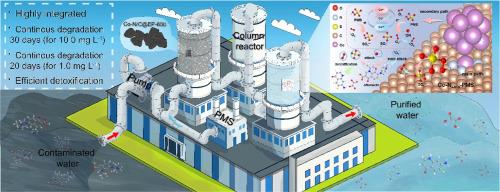Fixed-Bed Catalytic Antibiotics Detoxification through Singlet Oxygen-Mediated Nonradical Oxidation: Mechanisms and Long-Term Performance
IF 12.4
1区 环境科学与生态学
Q1 ENGINEERING, ENVIRONMENTAL
引用次数: 0
Abstract
This study presents an immobilized ZIF-67-derived catalyst, Co-N/C@EP-600, designed for efficient antibiotic detoxification via singlet oxygen (1O2)-mediated nonradical oxidation. The catalyst features a unique Co-N3 combined with Co nanocluster (Co-N3-NCs) structure, as confirmed by X-ray absorption fine structure (XAFS) and density functional theory (DFT) analyses. This structure enhances peroxymonosulfate (PMS) activation by reducing the energy barrier and promoting electron transfer, achieving ultrafast and complete degradation of ofloxacin (OFC, initial concentration of 10 mg L−1) and other refractory organic pollutants within 20 minutes. Mechanistic studies revealed that 1O2 dominates the oxidation process, affirmed by quenching tests, electron spin resonance (ESR), and isotopic experiments. The catalyst exhibited exceptional stability, maintaining >90% efficiency over 30 cycles with minimal cobalt leaching (<1.0 mg L⁻1). Practical application in a continuous-flow fixed-bed reactor demonstrated long-term performance, degrading fluoroquinolone antibiotics (OFC and enrofloxacin (ENR)) at high (10.0 mg L⁻1) and low (1.0 mg L⁻1) concentrations up to 30 and 20 days, respectively. Comprehensive toxicity assessments, encompassing microbial viability, activated sludge activity, and phytotoxicity assays, confirmed substantial detoxification toward fluoroquinolone antibiotics. This work provides a strategic blueprint for developing immobilized, eco-friendly catalysts that unite high performance, durability, and environmental compatibility in advanced wastewater treatment.

通过单线态氧介导的非自由基氧化固定床催化抗生素解毒:机制和长期性能
本研究提出了一种固定化的zif -67衍生催化剂Co-N/C@EP-600,设计用于通过单线态氧(1O2)介导的非自由基氧化有效解毒抗生素。通过x射线吸收精细结构(XAFS)和密度泛函理论(DFT)分析证实,该催化剂具有独特的Co- n3 - Co纳米簇(Co- n3 - nc)结构。该结构通过降低能垒和促进电子转移来增强过氧单硫酸盐(PMS)的活性,实现了对氧氟沙星(OFC,初始浓度为10 mg L−1)和其他难降解有机污染物在20分钟内的超快速和完全降解。机理研究表明,氧化过程以1O2为主,并得到了淬火实验、电子自旋共振(ESR)和同位素实验的证实。催化剂表现出优异的稳定性,在30次循环中保持90%的效率,钴浸出最少(1.0 mg L - 1)。在连续流动固定床反应器中的实际应用证明了长期的性能,在高浓度(10.0 mg L - 1)和低浓度(1.0 mg L - 1)下分别降解氟喹诺酮类抗生素(OFC和恩诺沙星(ENR))长达30天和20天。综合毒性评估,包括微生物活力、活性污泥活性和植物毒性测定,证实了对氟喹诺酮类抗生素的大量解毒作用。这项工作为开发固定化、环保型催化剂提供了战略蓝图,这些催化剂在废水深度处理中具有高性能、耐用性和环境相容性。
本文章由计算机程序翻译,如有差异,请以英文原文为准。
求助全文
约1分钟内获得全文
求助全文
来源期刊

Water Research
环境科学-工程:环境
CiteScore
20.80
自引率
9.40%
发文量
1307
审稿时长
38 days
期刊介绍:
Water Research, along with its open access companion journal Water Research X, serves as a platform for publishing original research papers covering various aspects of the science and technology related to the anthropogenic water cycle, water quality, and its management worldwide. The audience targeted by the journal comprises biologists, chemical engineers, chemists, civil engineers, environmental engineers, limnologists, and microbiologists. The scope of the journal include:
•Treatment processes for water and wastewaters (municipal, agricultural, industrial, and on-site treatment), including resource recovery and residuals management;
•Urban hydrology including sewer systems, stormwater management, and green infrastructure;
•Drinking water treatment and distribution;
•Potable and non-potable water reuse;
•Sanitation, public health, and risk assessment;
•Anaerobic digestion, solid and hazardous waste management, including source characterization and the effects and control of leachates and gaseous emissions;
•Contaminants (chemical, microbial, anthropogenic particles such as nanoparticles or microplastics) and related water quality sensing, monitoring, fate, and assessment;
•Anthropogenic impacts on inland, tidal, coastal and urban waters, focusing on surface and ground waters, and point and non-point sources of pollution;
•Environmental restoration, linked to surface water, groundwater and groundwater remediation;
•Analysis of the interfaces between sediments and water, and between water and atmosphere, focusing specifically on anthropogenic impacts;
•Mathematical modelling, systems analysis, machine learning, and beneficial use of big data related to the anthropogenic water cycle;
•Socio-economic, policy, and regulations studies.
 求助内容:
求助内容: 应助结果提醒方式:
应助结果提醒方式:


